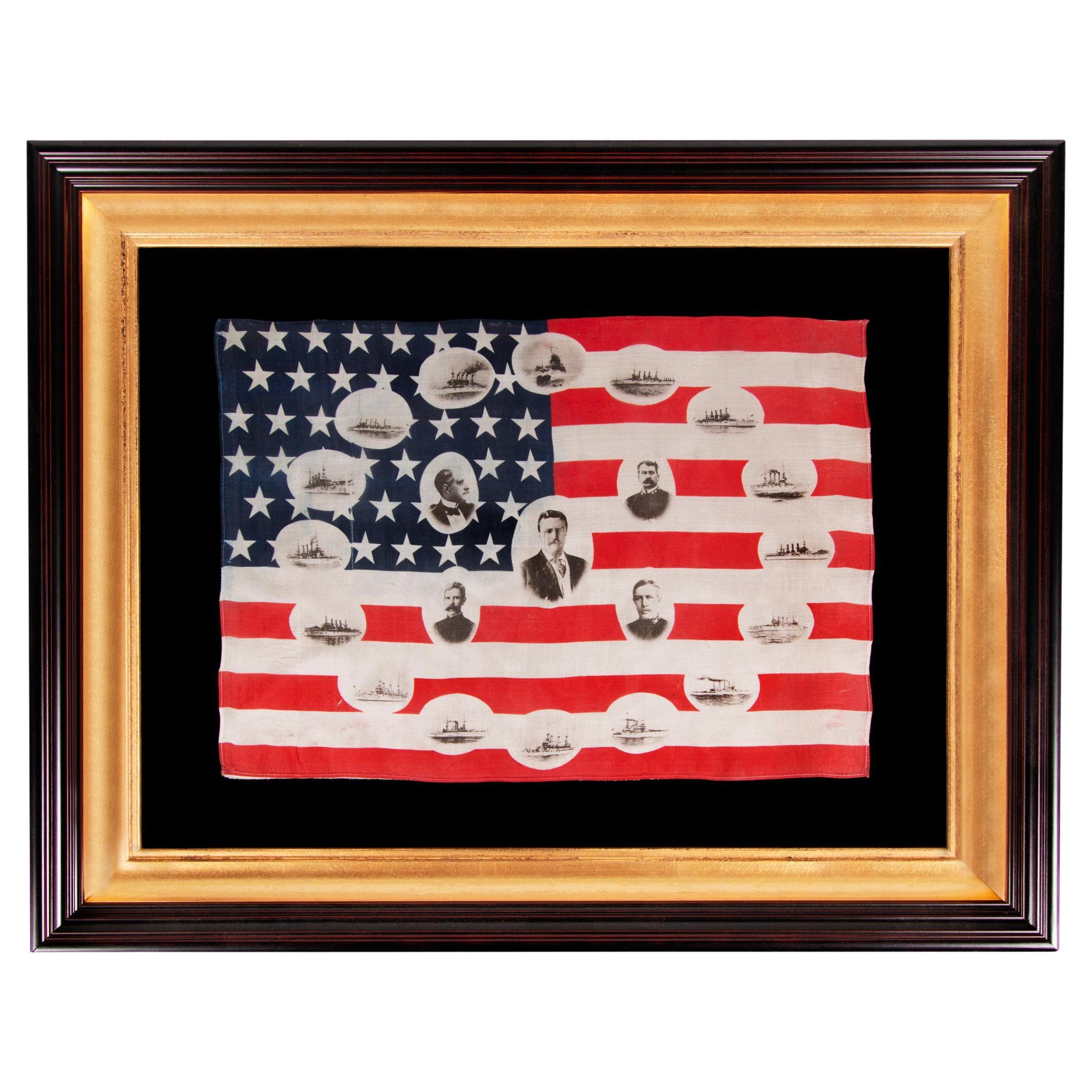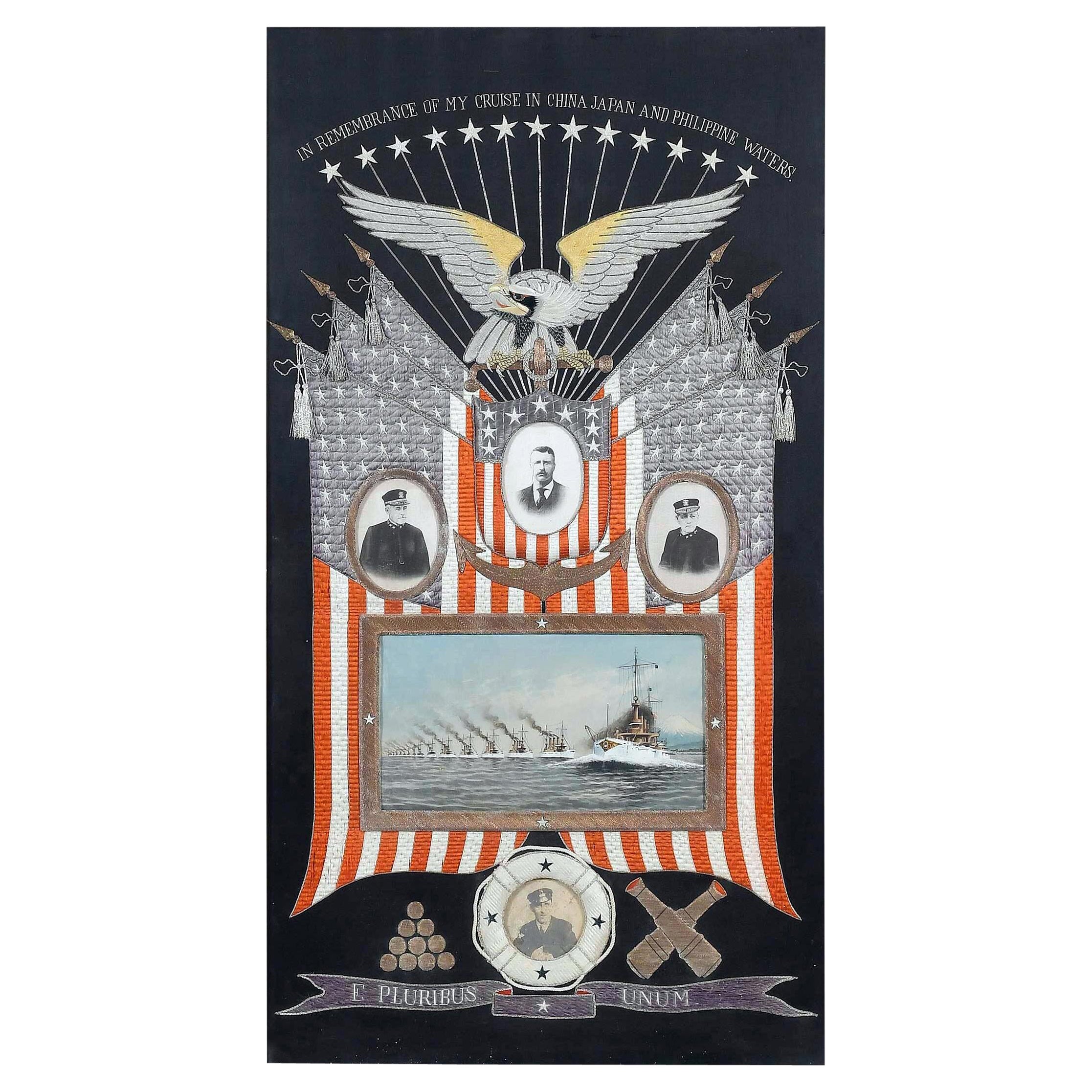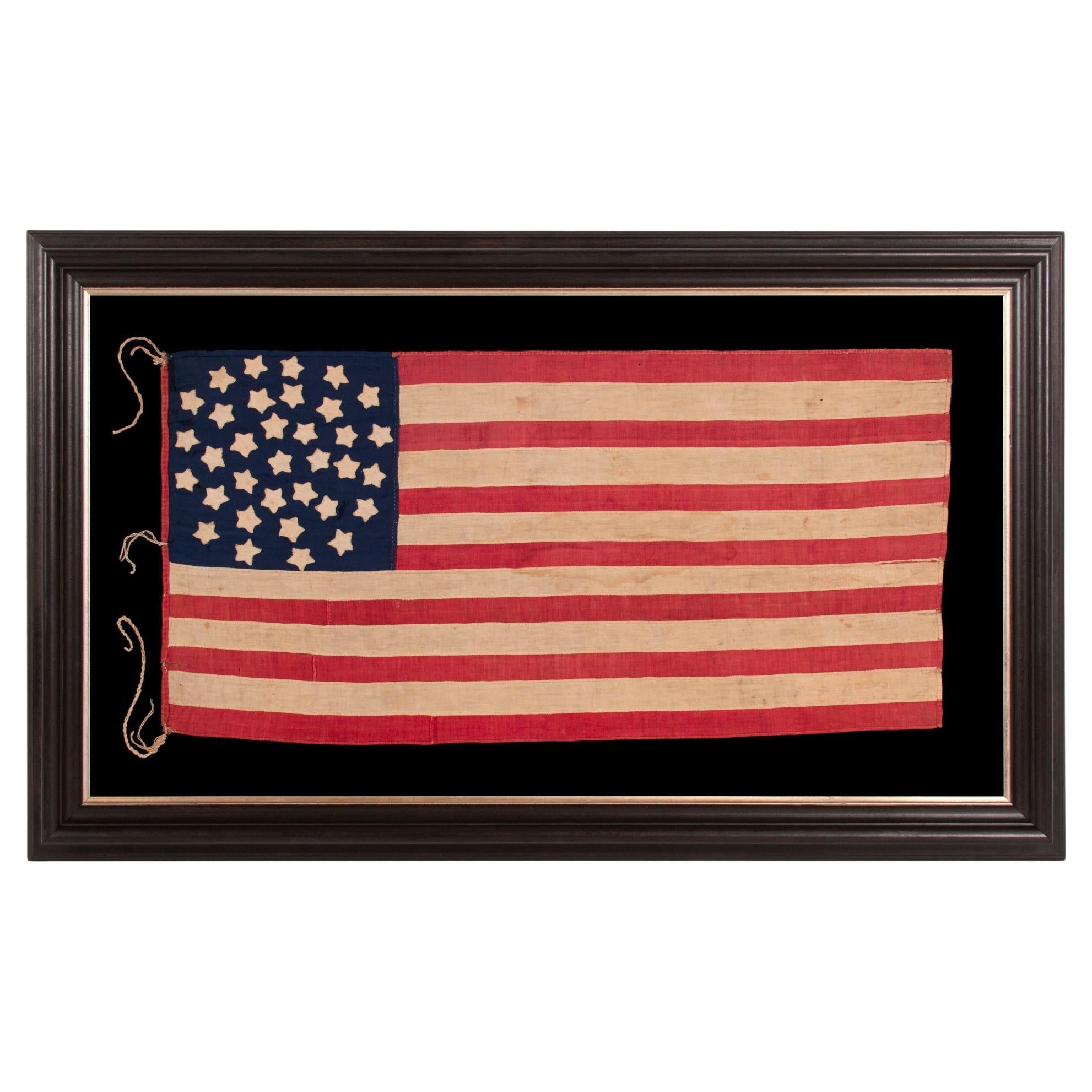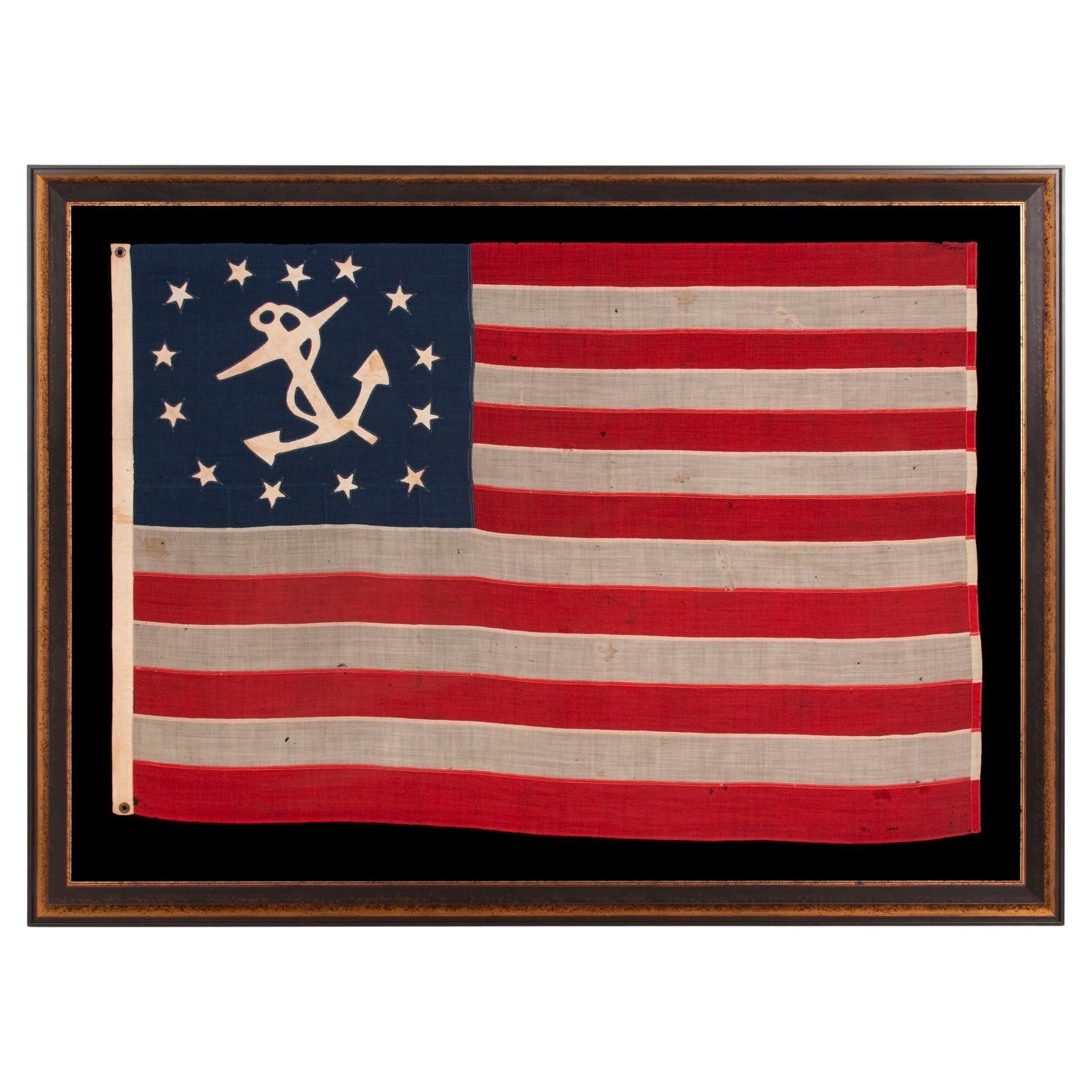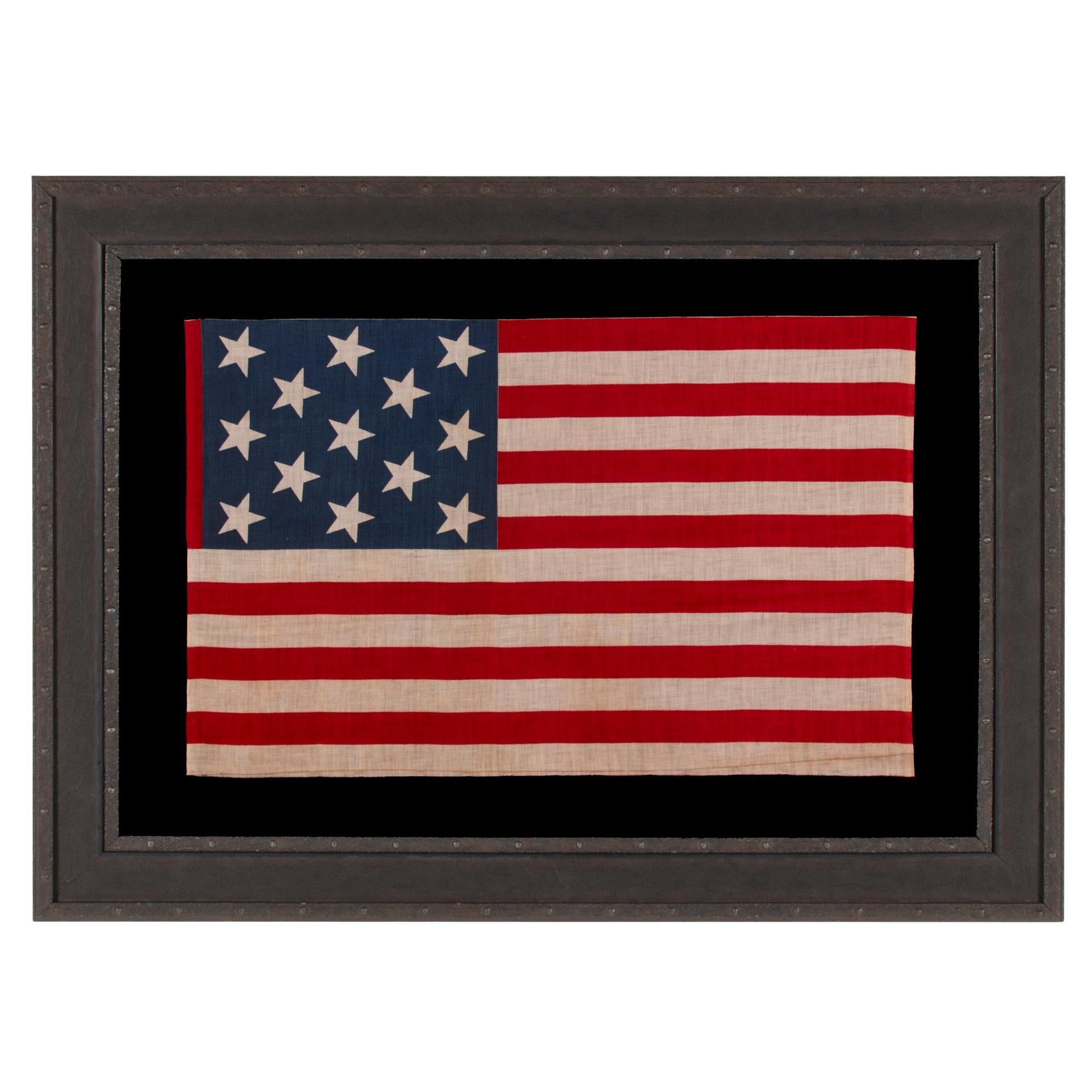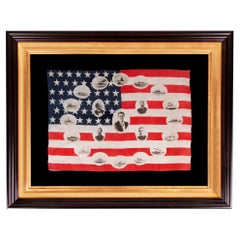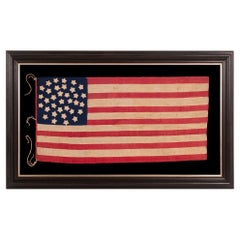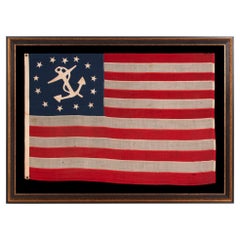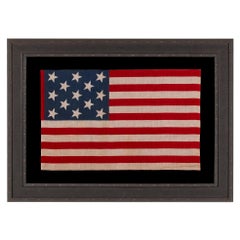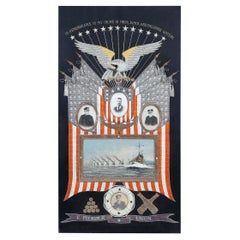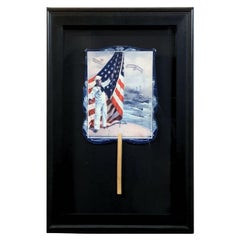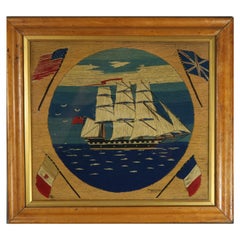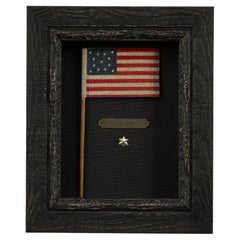Items Similar to Elaborate Sailor Souvenir of Washington Crossing the Delaware, circa 1885-1912
Want more images or videos?
Request additional images or videos from the seller
1 of 10
Elaborate Sailor Souvenir of Washington Crossing the Delaware, circa 1885-1912
Price Upon Request
Price Upon Request
Price Upon Request
Price Upon Request
Price Upon Request
Price Upon Request
Price Upon Request
Price Upon Request
Price Upon Request
Price Upon Request
About the Item
Elaborate sailor’s souvenir embroidery from the orient with a beautiful hand-painted image of Washington crossing the Delaware, surrounded by a large eagle, federal shield, crossed flags, a cannon, cannonballs, and anchor, circa 1885-1910:
Between roughly 1880 and 1915, American sailors visiting the orient could obtain beautiful needlework embroideries on shore, with patriotic American themes. These extraordinary works of art were acquired as mementos of a long voyage, often with the hope that they might be presented as gifts for loved ones and friends.
Using silk floss, elaborately embellished with both silver and gold metallic bullion thread, and combining various types of embroidery work and stitchery, as well as trapunto work to make them three-dimensional, artists created these elaborate pictures, making standardized designs or customizing them to the buyer's content. Executed on satin, like this example, or sometimes on velvet, the most common devices included eagles, flags, and shields, often with various maritime elements.
This particular example features a spread-winged, war-like eagle, with a cluster of arrows in each talon, above a canted, federal shield, flanked on either side by trios of American national flags, with metallic finials and tassels. In the lower center is a rectangular window, also bullion, with embroidered stars, that frames a rendition of Washington crossing the Delaware River on Christmas Eve to surprise British troops on Christmas Day. Expertly painted in watercolor on cloth, with beautiful colors and great detail, this image reproduces the 1851 oil-on-canvas painting by the German-American artist Emanuel Leutze. Note the artist’s liberty in the background that appears to feature Mt. Fugi on a mountainous, Japanese landscape, as opposed to the banks of the Delaware in New Jersey.
An anchor emerges from beneath the frame, flanked by crossed cannons and cannon balls. Along the bottom is a billowing streamer with the familiar American motto, in Latin, "E Pluribus Unum" (out of many, one).
This particular embroidery was made by “The Geo. Washington Company” in Yokohama, Japan. G. Fukughi opened his firm in 1880, with the intention of producing souvenirs for an audience of American Navymen. Advertising as a “Dealer in Fine Art Goods,” Fukughi employed expert painters and embroiderers who painstakingly produced these extraordinary textiles with some of the finest handwork one can encounter. His extraordinary business sold goods at points all over the orient, including not only Japan, but China, Taiwan, the Philippines, Korea, the Philippines, and elsewhere. I have seen them from ports as far as Hawaii. Over many years of viewing these textiles, I have seen dated examples as late as early as the 1880’s and as late as 1915. Due to the Spanish-American War (1898) and Roosevelt’s famous world tour of the “White Fleet” (1907-1909), this was an extremely patriotic era. Many of the members of the Great White Fleet came home with these embroideries.
Washington Crossing the Delaware was among the most elaborate of Fukughi’s standard designs. In my opinion, it was the best of them, especially when it did not include an open window for a portrait of the sailor.
When examining the level of craftsmanship, note the glass eye employed in the eagle and the tassels, carefully knotted from metallic bullion thread. Also note the treatment of the raised feathers on the legs, the scales on the talons, and the spiraling chain of the anchor. I have seen many of these embroideries, and while the mix of images here is not unusual, the attractive way in which they are sewn and displayed is excellent, as are the colors. The yellow in the wings is especially eye-catching.
Mounting: The textile was framed in our own conservation department. The black-painted and gilded molding is Italian, with a traditional American profile. The glazing is U.V. protective plexiglas.
Condition: Minor foxing in the painting. Minor to modest breakdown in the embroidery in the blue portion of the flags, accompanied by some fading in this region. Two of the stars are significantly soiled. The overall condition is extraordinary.
- Dimensions:Height: 45 in (114.3 cm)Width: 31 in (78.74 cm)Depth: 2.5 in (6.35 cm)
- Materials and Techniques:
- Place of Origin:
- Period:
- Date of Manufacture:1885-1910
- Condition:See Item Description.
- Seller Location:York County, PA
- Reference Number:Seller: pat-6631stDibs: LU849728455952
About the Seller
5.0
Recognized Seller
These prestigious sellers are industry leaders and represent the highest echelon for item quality and design.
Established in 1991
1stDibs seller since 2008
70 sales on 1stDibs
Typical response time: 16 hours
- ShippingRetrieving quote...Shipping from: York County, PA
- Return Policy
Authenticity Guarantee
In the unlikely event there’s an issue with an item’s authenticity, contact us within 1 year for a full refund. DetailsMoney-Back Guarantee
If your item is not as described, is damaged in transit, or does not arrive, contact us within 7 days for a full refund. Details24-Hour Cancellation
You have a 24-hour grace period in which to reconsider your purchase, with no questions asked.Vetted Professional Sellers
Our world-class sellers must adhere to strict standards for service and quality, maintaining the integrity of our listings.Price-Match Guarantee
If you find that a seller listed the same item for a lower price elsewhere, we’ll match it.Trusted Global Delivery
Our best-in-class carrier network provides specialized shipping options worldwide, including custom delivery.More From This Seller
View AllTeddy Roosevelt and His Great White Fleet American Flag, circa 1907-1909
Located in York County, PA
Rare & Beautiful American Parade Flag With Images Of Teddy Roosevelt And His Great White Fleet, 1907-1909, Ex-richard Pierce Collection:
46 star parade ...
Category
Antique Early 1900s American Political and Patriotic Memorabilia
Materials
Silk
Price Upon Request
34 STAR AMERICAN FLAG, CIVIL WAR, 1861-63, KANSAS STATEHOOD, 2nd KY CAVALRY
Located in York County, PA
34 STAR ANTIQUE AMERICAN FLAG OF THE CIVIL WAR PERIOD (1861-63), IN A TINY SCALE AMONG PIECED-AND-SEWN FLAGS OF THE PERIOD, WITH A TRIPLE-WREATH CONFIGURATION, AN ELONGATED FORMAT, AND ENTIRELY HAND-SEWN; FOUND WITH A LETTER FROM JOHN W. RUDE OF THE 2ND KENTUCKY VETERAN VOLUNTEER CAVALRY (UNION):
34 star flag of the Civil War period with a variety of extremely desirable features, handed down with a letter written by John W. Rude on November 8th, 1864, while encamped with the Army’s 1st Brigade, 3rd Division, as a member of the 2nd Regiment of Veteran Volunteer Cavalry. Tiny in scale among pieced and sewn examples, the flag displays a star pattern that consists of a three consecutive wreaths, with a single star in the very center. Because it lacks a single star in each corner, outside the basic pattern—usually present in flags of this design made during the mid-late 19th century—this is something I classify as a “snowball medallion.” Entirely hand-sewn throughout, note the square format of the blue canton, with its beautiful, circular star arrangement, and how interesting this combination is when paired with the elongated format of the flag itself. The stars are double-appliqued, meaning that they are applied to both sides. These are fat in shape and inconsistent in size. Note how the lowest star in the outermost ring actually dips into the white stripe below.
Made of plain weave cotton, there is a narrow binding along the hoist, red in color, with three sets of cotton ties. Those at the top and bottom are made of fine, braided hemp or hemp and cotton cord, stitched into place, while the one in the center, looped around the binding and tied, is made of lightweight, twisted, cotton thread. Note how the 5th, 6th, and 7th red stripes are pieced from two lengths of cotton fabric, which reflects that the maker was being conscious of conserving available fabric.
In the 19th century, most flags with pieced and sewn construction were 8 feet long and larger. A six-footer was considered small. Even military battle flags, carried on foot, measured 6’ x 6.5’, which translates into approximately 7’ x 7.5’ after framing, about the size of an average quilt and larger than can comfortably fit on a wall in a house with 8-foot ceilings and average width baseboard. Flags smaller than this exist, but the smaller they get, the more unusual they are. At just 1.5’ x 3’, this is about as small as one will ever encounter in a sewn flag of the Civil War era.
The flag appears to have likely been hand-carried. I expect that it probably saw military use of some sort as a camp flag...
Category
Antique 1860s American Political and Patriotic Memorabilia
Materials
Cotton
Outstanding 13 Star Hand-sewn American Private Yacht Flag, ca 1865-1885
Located in York County, PA
OUTSTANDING, 13 STAR, ANTIQUE AMERICAN PRIVATE YACHT ENSIGN WITH GREAT FOLK QUALITIES THAT INCLUDE AN UNUSUALLY WIDE ANCHOR AND A DECIDEDLY LOPSIDED RING OF 13 STARS; MADE DURING THE 2ND HALF OF THE 19TH CENTURY; ITS DEVICE HAND-SEWN AND SINGLE-APPLIQUÉD
Private yacht ensigns were approved American signals for maritime use that allowed pleasure boats to bypass customs. Though the legislation that approved them was adopted prior to 1850, almost all such flags that one will encounter were sewn by electric machine and made during the 20th century. The unusual gems among surviving examples are those that are earlier and include hand-sewn elements. Even more rare are a select few with atypical graphics. Barely any fall into both of these categories at once. Take note of the anchor on this particular flag, wide a long horizontal crossbar (stock) that contributes to uncommonly wide stance. Set within a ring of stars that is decidedly lopsided, the result is as bold as it is endearingly whimsical—two of the best qualities in American folk art, a category in which this particular example can be filed. While I have owned 13 star private yacht flags that have displayed star and canted anchor devices that were somewhat larger and/or bolder than typical, I cannot recall any that were so graphically intriguing as this one.
Brief History of Private Yacht Ensigns:
The medallion configuration, 13-star, 13-stripe flag, with a canted center anchor was entered into official use in 1848, following an act of Congress, that made it the official signal for U.S. pleasure sailing vessels. The need for such a flag arose with the popularity of boating as a pastime for well-to-do Americans, and as a competitive sport, in addition to its longstanding utilitarian role as a vehicle of trade. In early America, all boats were subject to customs searches at every port. Without modern income tax, the federal government derived its revenues mostly from tariffs, so an accounting of foreign goods on ships was a critical venture. As yachting for pleasure became more prevalent, however, more and more time was spent searching boats that had no such inventory, wasting time for both customs officials and wealthy ship owners.
John Cox Stevens, a former president of the Jockey Club and future founder of the Union League Club, became the New York Yacht Club’s Commodore upon its founding in 1845. In 1847 he approached the secretary of the treasury and suggested that something be done to streamline the customs process for non-trade vessels. In 1848, legislation passed Congress requiring registration of these boats, which could then fly the “American Yachting Signal” to bypass customs. This remained on the books until the 1980’s, when the 1848 legislation was revoked, but the use of flags in this design for decorative function continues to this day.
13 star flags have been flown throughout our nation’s history for a variety of purposes. In addition to their use on private yachts, they were hoisted at patriotic events, including Lafayette’s final visit in 1824-25, the celebration of the nation’s centennial in 1876, and the sesquicentennial in 1926. They were displayed during the Civil War, to reference past struggles for American liberty and victory over oppression, and were used by 19th century politicians while campaigning for the same reason. The U.S. Navy used the 13 star count on small boats until 1916, because it was easier to discern fewer stars at a distance on a small flag. Commercial flag-makers mirrored this practice and some private ships flew 13 star flags during the same period as the Navy.
Construction: The stars and anchor are made of cotton, hand-sewn, and single-appliquéd. This means that they were applied to one side of the canton, then the blue fabric was cut from behind each star, folded over, and under-hemmed, so that one star could be viewed on both sides of the flag. I always find single-appliquéd stars more interesting, not only because they are evidence of a more difficult level of seam-work and stitching, but also because they are more visually intriguing. The two visible rows of hand-stitching emphasize their hand-sewn construction. For these reasons, single-appliquéd stars often appeal to connoisseurs of early American textiles...
Category
Antique Mid-19th Century American Political and Patriotic Memorabilia
Materials
Wool
Price Upon Request
13 Star Antique American Parade Flag, ca 1876-1899
Located in York County, PA
13 STAR ANTIQUE AMERICAN PARADE FLAG, WITH A 3-2-3-2-3 CONFIGURATION OF STARS, AN EXTREMELY SCARCE AND UNUSUALLY LARGE VARIETY, MADE circa 1876-1899
13 star American national parade...
Category
Antique Late 19th Century Canadian Political and Patriotic Memorabilia
Materials
Cotton
Price Upon Request
42 Stars on a Antique American Parade Flag, Washington Statehood, ca 1889-1890
Located in York County, PA
42 STARS ON AN ANTIQUE AMERICAN FLAG WITH A WAVE CONFIGURATION OF LINEAL COLUMNS, AN UNOFFICIAL STAR COUNT THAT REFLECTS THE ADDITION OF WASHINGTON STATE, MONTANA, AND THE DAKOTAS, c...
Category
Antique Late 19th Century American Political and Patriotic Memorabilia
Materials
Cotton
13 Star Antique American Flag, Marked "R.H Macy & Co", circa 1895-1926
Located in York County, PA
13 STAR ANTIQUE AMERICAN FLAG WITH A 3-2-3-2-3 CONFIGURATION OF STARS; A SMALL-SCALE EXAMPLE, MADE IN THE 1895-1926 ERA, MARKED “R.H. MACY & CO.”
13 star antique American flag of th...
Category
Antique Late 19th Century American Political and Patriotic Memorabilia
Materials
Wool
Price Upon Request
You May Also Like
Japanese Antique Textile Panel of American Historical Great White Fleet
Located in Atlanta, GA
Nicknamed Great White Fleet, the sailing of the United States Navy battleships around the globe from December 16, 1907 to February 22, 1909 by order of Uni...
Category
Antique Early 1900s Japanese Japonisme Textiles
Materials
Brocade, Silk, Wood
Navy Sailor Patriotic Printed Paddle Fan, Early 20th Century
Located in Colorado Springs, CO
Presented is a patriotic printed paddle fan, with an image of a Navy sailor. The sailor is depicted on the back of a large boat, standing in front of a large, waving American flag. I...
Category
Early 20th Century American Political and Patriotic Memorabilia
Materials
Wood, Paper
Sailor's Woolwork Picture of a Ship with American Flag
Located in Chelmsford, Essex
Sailor's Woolwork Embroidery Picture of a Ship surrounded by flags. Picture has a central panel depicting a three masted navy ship at sea. Flags in each corner - American, British, F...
Category
Antique Late 19th Century Tapestries
Materials
Wool
13-Star Flag Waver for the Centennial Celebration
Located in Colorado Springs, CO
This small charming 13-star flag waver was made for and sold during the nation’s Centennial celebration in Philadelphia in 1876. All manner of flags were made for the official Centen...
Category
Antique 1870s American Federal Political and Patriotic Memorabilia
Materials
Fabric
A Victorian wool picture of a three masted frigate flying several flags and ensi
Located in Lymington, Hampshire
A Victorian wool picture of a three masted frigate flying several flags and ensigns, within a border of red, blue and white trellis, in the original frame, regilded. English, circa ...
Category
Antique Mid-19th Century English Nautical Objects
Materials
Wool
31-Star Printed American Flag, Celebrating California Statehood, Circa 1850
Located in Colorado Springs, CO
This is a rare 31-star medallion printed American flag, celebrating the addition of California to the Union. The flag is printed on silk and has a spectacular “Great Star” canton pat...
Category
Antique 1850s American Political and Patriotic Memorabilia
Materials
Silk
More Ways To Browse
Antique Souvenir
Antique Delaware
Korean Folk Art
Maritime Antiques
Japanese Watercolor Paintings
Federal Eagle
Antique Glass Eye
Large Cannon
Love Knot Chain
Gold Bullion
Japanese Flag
Large Japanese Eagle
Italian Needlework
Large Rectangular Oil Paintings
Eagle Shield
Made In Italy Gold Chain V
Antique Anchor Chain
Patriotic Shield
